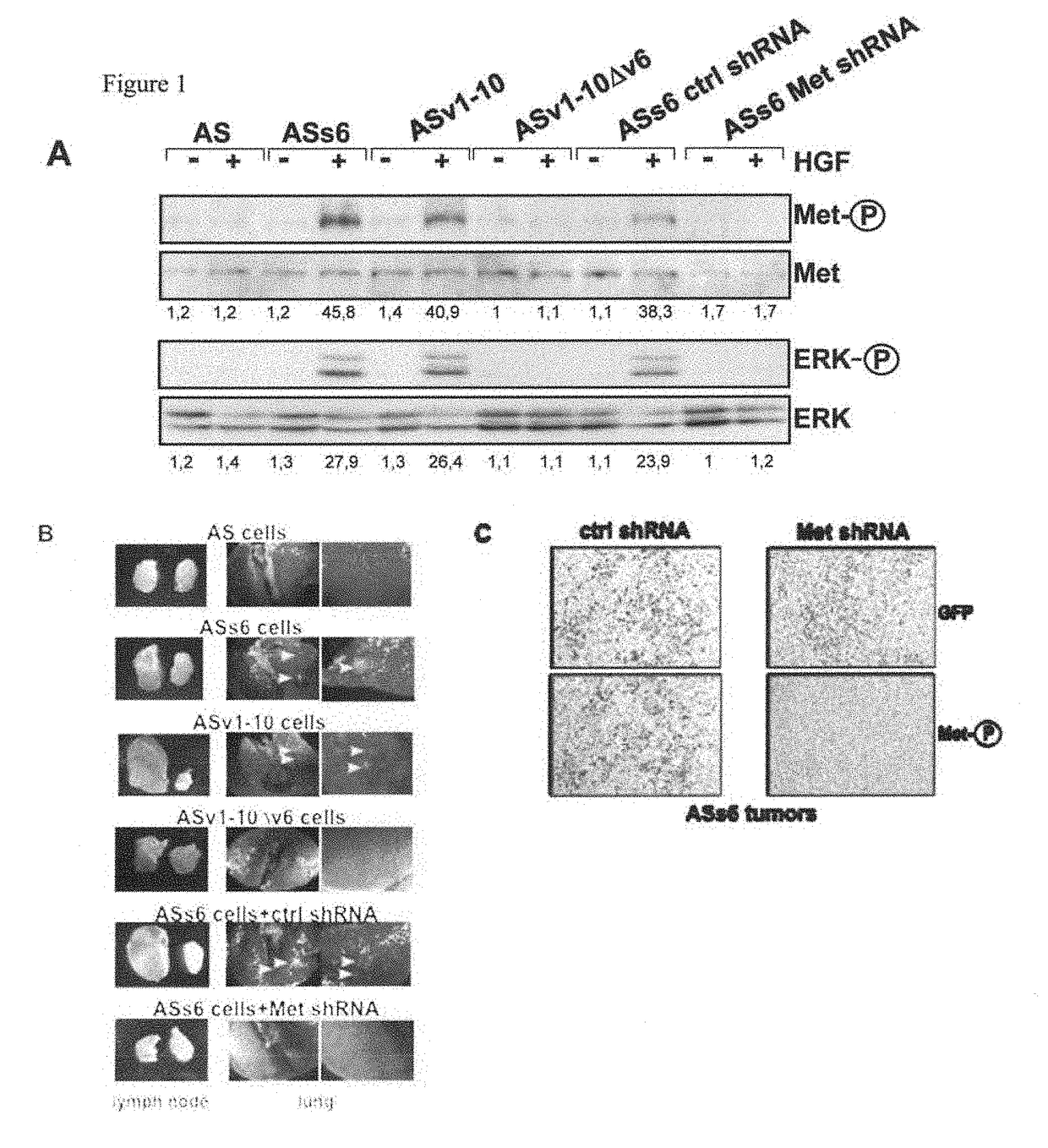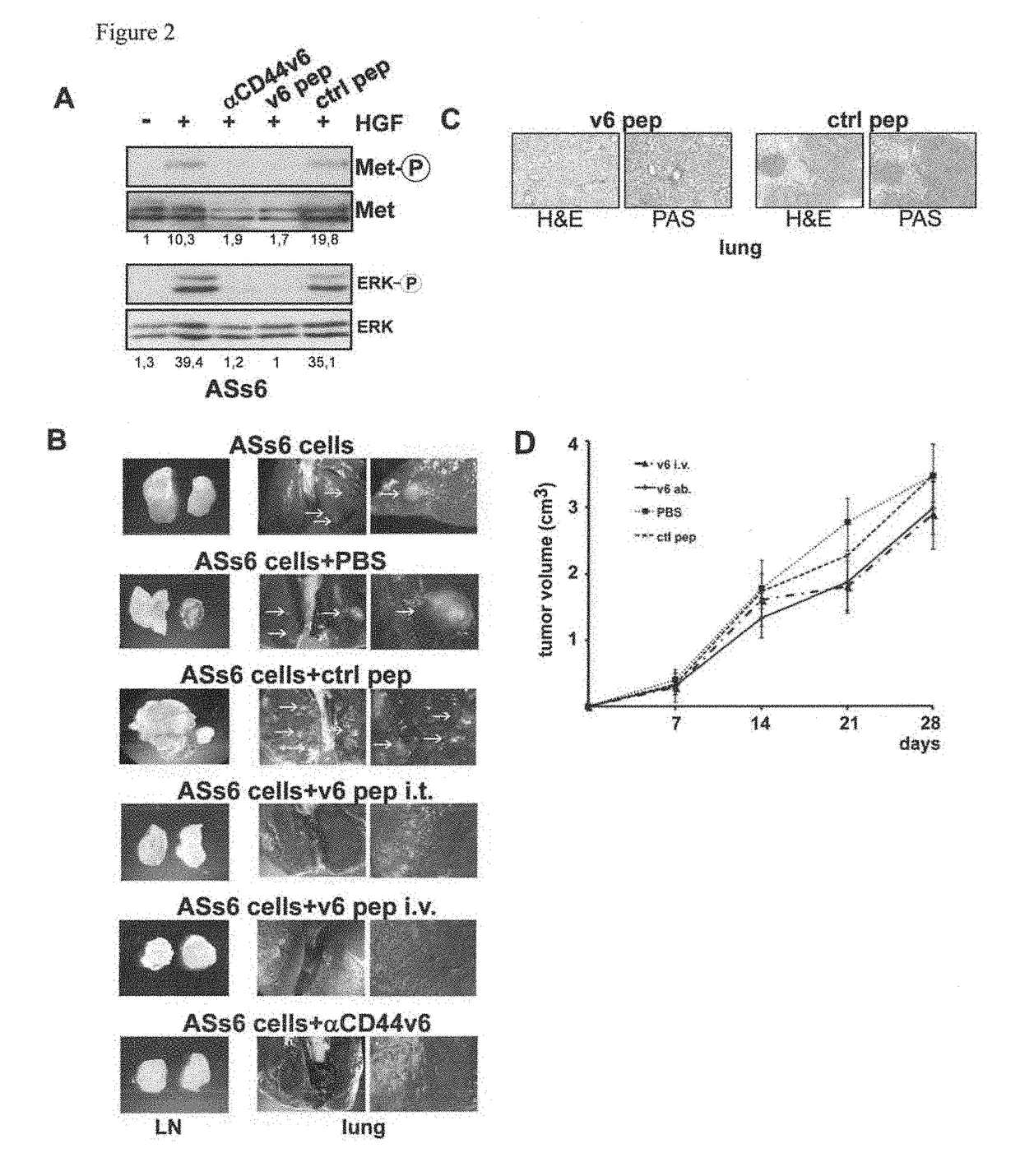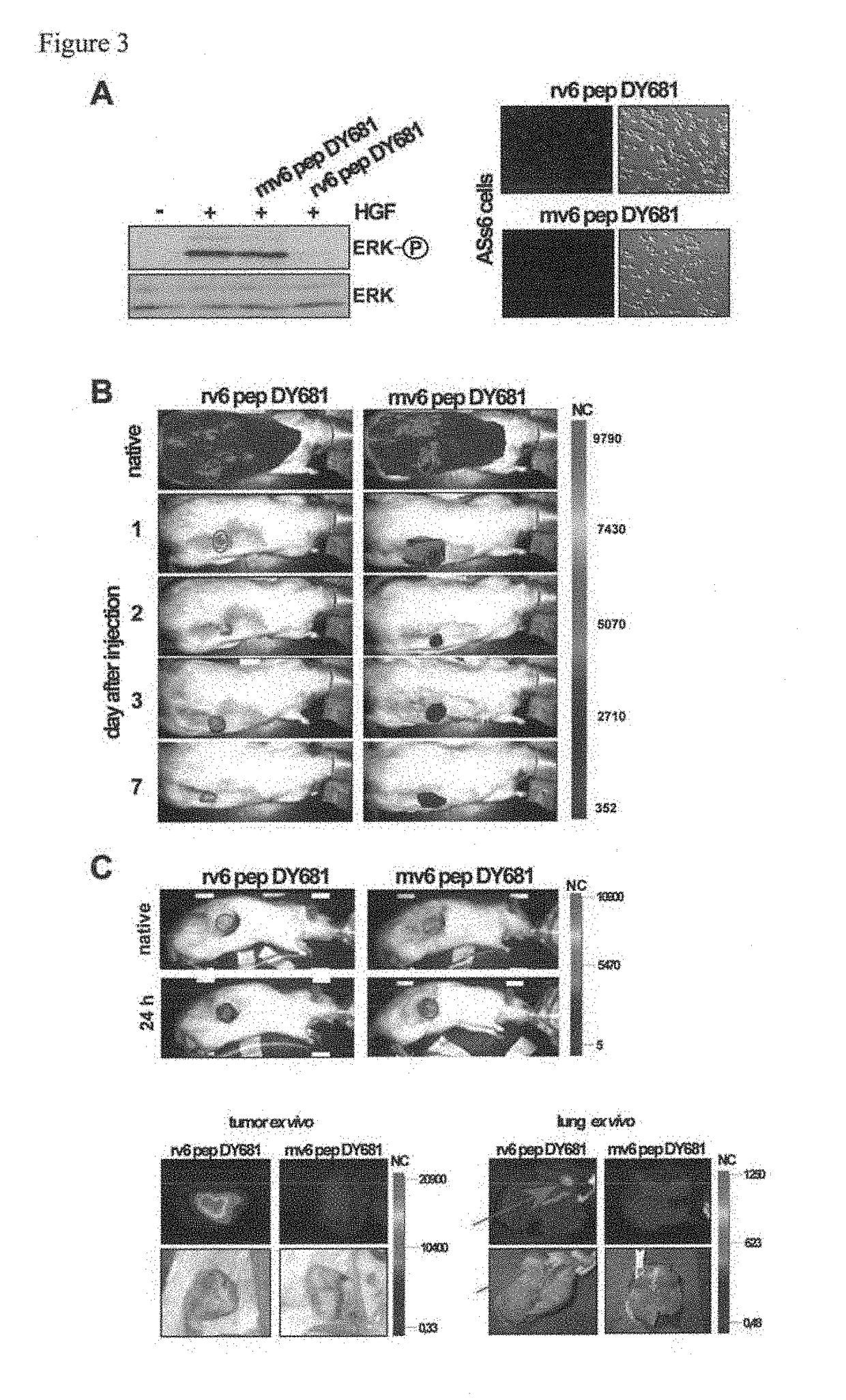CD44V6-Derived Peptides for Treating Metastasizing Cancer
a peptide and metastasizing technology, applied in the field of compounds, pharmaceutical compositions and methods for treating metastasizing forms of cancer, can solve the problems of long-term progression-free survival, no treatment currently available, similar problems exist for other cancers, etc., and achieve the effect of reducing the number of tumors
- Summary
- Abstract
- Description
- Claims
- Application Information
AI Technical Summary
Benefits of technology
Problems solved by technology
Method used
Image
Examples
example 1
1. Material and Methods
1.1 Cell Lines
[0126]The rat pancreatic carcinoma cell line BSp73AS (also designated AS) and its transfectants have been described (Orian-Rousseau et al., Genes &Development (2002), 16:3074-3086) and were grown in RPMI (Invitrogen, Karlsruhe, Germany) plus 10% FCS (PAA, Cölbe, Germany). The human pancreatic cancer cells L3.6pl (Bruns et al., Neoplasia (1999), 1, 50-62) were maintained in DMEM (low glucose; Invitrogen, Karlsruhe, Germany) supplemented with 10% FCS (PAA, Cölbe, Germany), sodium pyruvate, nonessential amino acids, L-glutamine, and MEM vitamin solution (Pan Biotech, Aidenbach Germany).
1.2 Antibodies and Other Reagents
[0127]The human monoclonal antibody against CD44v6 (VFF18) was a gift from Bender (eBioscience, Campus Vienna Biocenter 2, A-1030, Vienna, Austria), the anti-ERK 1 (K-23), c-Met (C-28) and GFP antibody (sc-101525) were from Santa Cruz Biotechnology (Heidelberg, Germany), the cleaved Caspase-8 antibody (IMG-5703) from Imgenex (San Diego...
example 2
CD44v6 Peptides Inhibit HGF Dependent CD44v6 Mediated Signaling
1. Material and Methods
1.1 Synthesis of Pegylated Peptides
[0155]Peptide synthesis was performed on an Applied Biosystems automated peptide synthesizer (model 433A) and the peptides were purified by preparative HPLC. Peptides of sequences NEWQG (SEQ ID No.: 11) and a control peptide NAAAG (SEQ ID No.: 15) were synthesized. Crude and purified products were characterized by LC coupled to a mass spectrometer (μTOF LCMS from Bruker Daltonics-Bremen, Germany).
[0156]Peptide synthesis was performed using standard Fmoc solid phase peptide synthesis protocols (see e.g. Fields et al., Int J Pept Protein Res. (1990), 35, 161-214, Maisch et al., J Am Chem Sco. (2009), 131, 15596-15597, Strandberg et al., Biophys J. (2006), 90, 1676-1686, and Wadhwani et al., J Org Chem. (2006), 71, 55-61). Fmoc deprotection was done with 20-22% piperidine in NMP. Coupling was performed using a mixture of Fmoc-amino acid:HOBt: HBTU:DIEA (4:4:3.9:8) in...
example 3
Results
Linear CD44v6 Peptides Described Herein
[0167]
rat: (SEQ ID NO: 10)14 mer KEKWFENEWQGKNP, (SEQ ID NO: 11)5 mer NEWQG, (SEQ ID NO: 12)DY681labeled 11 mer WFENEWQGKNP human: (SEQ ID NO: 6)14 mer KEQWFGNRWHEGYR, (SEQ ID NO: 2)5 mer NRWHE, (SEQ ID NO: 14)DY681labeled 11 mer WFGNRWHEGYR mouse: (SEQ ID NO: 13)DY681labeled 11 mer WFQNGWQGKNP
1. In Vitro Inhibition of RTKs Using the Human v6 Peptides
[0168]Linear peptide (human, 14mer KEQWFGNRWHEGYR (SEQ ID NO: 6), 5mer NRWHE (SEQ ID NO: 2))
Cell Lines Used
[0169]HT29 (colorectal cancer)
HUVEC (human umbilical vein endothelial cells)
HCMEC (human cardiac microvascular EC)
HAOEC (human aortic EC)
L3.6pl (human pancreatic carcinoma cell)
MCF7 (human breast cancer)
1.1 Endothelial Cells
[0170]In order to analyse whether CD44v6 acts as a co-receptor for Met in angiogenesis, several primary ECs isolated from different kinds of human blood vessels were used. ECs can differ in shape, function and in the type of cell-cell junctions...
PUM
| Property | Measurement | Unit |
|---|---|---|
| time | aaaaa | aaaaa |
| size | aaaaa | aaaaa |
| molecular weight | aaaaa | aaaaa |
Abstract
Description
Claims
Application Information
 Login to View More
Login to View More - R&D
- Intellectual Property
- Life Sciences
- Materials
- Tech Scout
- Unparalleled Data Quality
- Higher Quality Content
- 60% Fewer Hallucinations
Browse by: Latest US Patents, China's latest patents, Technical Efficacy Thesaurus, Application Domain, Technology Topic, Popular Technical Reports.
© 2025 PatSnap. All rights reserved.Legal|Privacy policy|Modern Slavery Act Transparency Statement|Sitemap|About US| Contact US: help@patsnap.com



